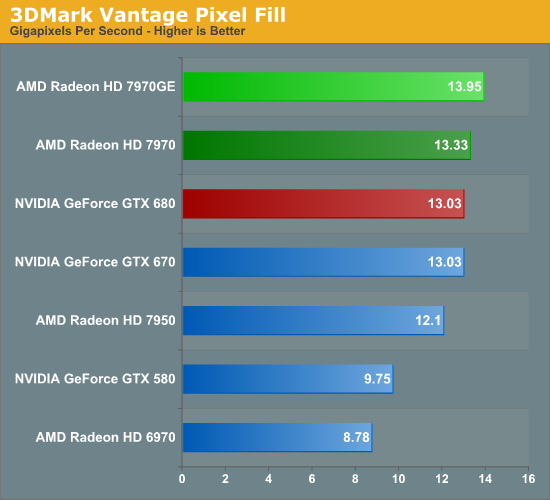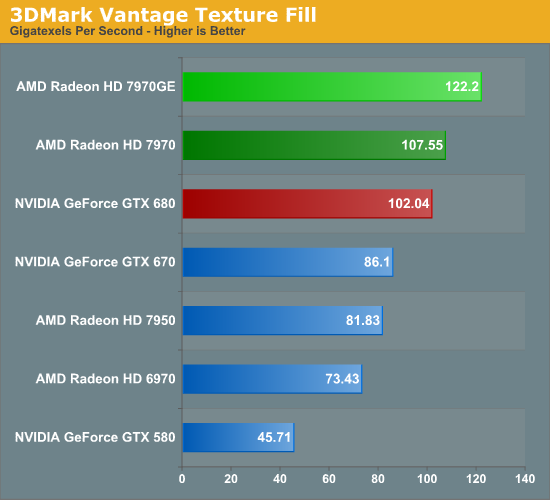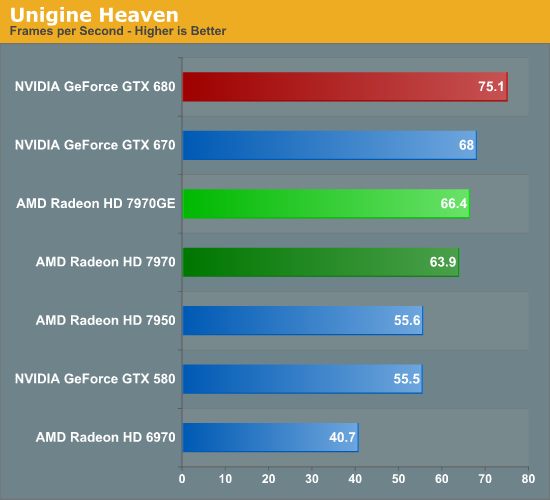AMD Radeon HD 7970 GHz Edition Review: Battling For The Performance Crown
by Ryan Smith on June 22, 2012 12:01 AM EST- Posted in
- GPUs
- AMD
- GCN
- Radeon HD 7000
Synthetics
Because the 7970GE uses the same architecture – and indeed same chip as the 7970 – there’s not much to report here with synthetic performance, but we’ll quickly run through the numbers.


Starting with 3DMark Pixel and Texel Fill, the 7970GE improves on the 7970 around as expected. Pixel fill is a bit low at only 4.5% though, which is unexpected since the 7970GE got a big boost in both its core clock and its memory clock.


Next up is tessellation. While at normal tessellation levels we’re CPU or otherwise throughput limited, at maximum tessellation levels the 7970GE further improves upon the 7970 by 13%, which means we’re likely seeing the full impact of PT Boost in action here. However at this performance level we’re also approaching the same throughput limits we saw with normal tessellation, which means that we either need a better test or GPUs are reaching the point where they have more than enough tessellation performance for future games.

Finally we have Unigine’s Heaven. The GTX 600 series has always done well here, and while the 7970GE improves on the 7970, the GTX 680 is still well ahead for what it’s worth.










110 Comments
View All Comments
piroroadkill - Friday, June 22, 2012 - link
While the noise is bad - the manufacturers are going to spew out non-reference, quiet designs in moments, so I don't think it's an issue.silverblue - Friday, June 22, 2012 - link
Toms added a custom cooler (Gelid Icy Vision-A) to theirs which reduced noise and heat noticably (about 6 degrees C and 7-8 dB). Still, it would be cheaper to get the vanilla 7970, add the same cooling solution, and clock to the same levels; that way, you'd end up with a GHz Edition clocked card which is cooler and quieter for about the same price as the real thing, albeit lacking the new boost feature.ZoZo - Friday, June 22, 2012 - link
Would it be possible to drop the 1920x1200 definition for test? 16/10 is dead, 1080p has been the standard for high definition on PC monitors for at least 4 years now, it's more than time to catch up with reality... Sorry for the rant, I'm probably nitpicking anyway...Reikon - Friday, June 22, 2012 - link
Uh, no. 16:10 at 1920x1200 is still the standard for high quality IPS 24" monitors, which is a fairly typical choice for enthusiasts.paraffin - Saturday, June 23, 2012 - link
I haven't been seeing many 16:10 monitors around thesedays, besides, since AT even tests iGPU performance at ANYTHING BUT 1080p your "enthusiast choice" argument is invalid. 16:10 is simply a l33t factor in a market dominated by 16:9. I'll take my cheap 27" 1080p TN's spaciousness and HD content nativiness over your pricy 24" 1200p IPS' "quality" anyday.CeriseCogburn - Saturday, June 23, 2012 - link
I went over this already with the amd fanboys.For literally YEARS they have had harpy fits on five and ten dollar card pricing differences, declaring amd the price perf queen.
Then I pointed out nVidia wins in 1920x1080 by 17+% and only by 10+% in 1920x1200 - so all of a sudden they ALL had 1920x1200 monitors, they were not rare, and they have hundreds of extra dollars of cash to blow on it, and have done so, at no extra cost to themselves and everyone else (who also has those), who of course also chooses such monitors because they all love them the mostest...
Then I gave them egg counts, might as well call it 100 to 1 on availability if we are to keep to their own hyperactive price perf harpying, and the lowest available higher rez was $50 more, which COST NOTHING because it helps amd, of course....
I pointed out Anand pointed out in the then prior article it's an ~11% pixel difference, so they were told to calculate the frame rate difference... (that keeps amd up there in scores and winning a few they wouldn't otherwise).
Dude, MKultra, Svengali, Jim Wand, and mass media, could not, combined, do a better job brainwashing the amd fan boy.
Here's the link, since I know a thousand red-winged harpies are ready to descend en masse and caw loudly in protest...
http://translate.google.pl/translate?hl=pl&sl=...
1920x1080: " GeForce GTX680 is on average 17.61% more efficient than the Radeon 7970.
Here, the performance difference in favor of the GTX680 are even greater"
So they ALL have a 1920x1200, and they are easily available, the most common, cheap, and they look great, and most of them have like 2 or 3 of those, and it was no expense, or if it was, they are happy to pay it for the red harpy from hades card.
silverblue - Monday, June 25, 2012 - link
Your comparison article is more than a bit flawed. The PCLab results, in particular, have been massively updated since that article. Looks like they've edited the original article, which is a bit odd. Still, AMD goes from losing badly in a few cases to not losing so badly after all, as the results on this article go to show. They don't displace the 680 as the best gaming card of the moment, but it certainly narrows the gap (even if the GHz Edition didn't exist).Also, without a clear idea of specs and settings, how can you just grab results for a given resolution from four or five different sites for each card, add them up and proclaim a winner? I could run a comparison between a 680 and 7970 in a given title with the former using FXAA and the latter using 8xMSAA, doesn't mean it's a good comparison. I could run Crysis 2 without any AA and AF at all at a given resolution on one card and then put every bell and whistle on for the other - without the playing field being even, it's simply invalid. Take each review at its own merits because at least then you can be sure of the test environment.
As for 1200p monitors... sure, they're more expensive, but it doesn't mean people don't have them. You're just bitter because you got the wrong end of the stick by saying nobody owned 1200p monitors then got slapped down by a bunch of 1200p monitor owners. Regardless, if you're upset that NVIDIA suddenly loses performance as you ramp up the vertical resolution, how is that AMD's fault? Did it also occur to you that people with money to blow on $500 graphics cards might actually own good monitors as well? I bet there are some people here with 680s who are rocking on 1200p monitors - are you going to rag (or shall I say "rage"?) on them, too?
If you play on a 1080p panel then that's your prerogative, but considering the power of the 670/680/7970, I'd consider that a waste.
FMinus - Friday, June 22, 2012 - link
Simply put; No!1080p is the second worst thing that happened to the computer market in the recent years. The first worst thing being phasing out 4:3 monitors.
Tegeril - Friday, June 22, 2012 - link
Yeah seriously, keep your 16:9, bad color reproduction away from these benchmarks.kyuu - Friday, June 22, 2012 - link
16:10 snobs are seriously getting out-of-touch when they start claiming that their aspect ratio gives better color reproduction. There are plenty of high-quality 1080p IPS monitors on the market -- I'm using one.That being said, it's not really important whether it's benchmarked at x1080 or x1200. There is a neglible difference in the number of pixels being drawn (one of the reasons I roll my eyes at 16:10 snobs). If you're using a 1080p monitor, just add anywhere from 0.5 to 2 FPS to the average FPS results from x1200.
Disclaimer: I have nothing *against* 16:10. All other things being equal, I'd choose 16:10 over 16:9. However, with 16:9 monitors being so much cheaper, I can't justify paying a huge premium for a measily 120 lines of vertical resolution. If you're willing to pay for it, great, but kindly don't pretend that doing so somehow makes you superior.